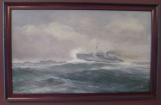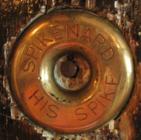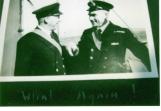1
The following is a reading of a letter by Tahirah Shadforth, grandaughter of Lt. Cdr.Bert Shadforth, captain of HMCS Spikenard. The letter is written by a survivor of the sinking of HMCS Spikenard to Shadforth's brother.2
The Letter, A Survivor's Recollection of the Fate of the Spikenard and Its Captain, H.G. ShadforthFebruary 1942
St. John's, Newfoundland, Canada
 Credits:
Credits:Tahirah Shadforth
Jacquey Ryan
2007-2008 Album, Crow's Nest
3
Dear Sir,Today, I received your letter inquiring about your brother, my late Commander. I'm sorry I cannot give you any hope of his survival.
You no doubt would like to know why and also what happened to convince me Lieut.
Shadforth was lost.
On the night of Tuesday, 10th February (1942), AT 11:30 PM, a torpedo struck the Spikenard just forward of the bridge and must have killed any one of the officers who happened to be in the wardroom. Your brother, I believe, was on the bridge at the time of the explosion. I was asleep in the petty officers' mess at the time and upon arrival on deck saw part of the bridge blown away and the forward end of the ship right back to the life-boats-this included the bridge - in flames.
Someone on the bridge, I think Lieut. Shadforth, was blowing "Abandon Ship" on the whistle. She went down by the head very fast and disappeared in 3 minutes. She was a small ship and the torpedo must have nearly broken her in halves.
Eight of us were picked up the next evening after 18 and a half hours on a raft. The port life-boat was smashed in the explosion. The starboard boat was in flames and one Carley float lashed near the boats, could not be reached and went down lashed to the ship.
There was one other float and the raft back aft. I got the float free and three others got the lashings off of the float and picked up four others who were in the water.
Immediately after she sunk there followed an underwater explosion. It may have been the boilers or a depth charge. I had a miraculous escape after being blown off the raft and coming to under the water going down with the ship. I made the surface and heard them talking on the float and swam to them. We changed over to the raft and heard a few more cries in the water. We managed to pick up two, and ordinary seaman and a leading stoker, but both were injured internally and died before noon the next day. There were no more cries and we settled down to wait.
On being picked up by an English corvette, we learned we had not been reported sunk and no on knew we were lost. The English corvette queried our whereabouts at 11am, and obtained permission to return and search for survivors. The first definite information regarding her loss was gained from us.
Therefore, I fail to see how any others were picked up before us or they would have known, and I don't think anyone in the water at the time of the explosion would have escaped injury. If anyone did get clear, I don't think they would have survived as the temperature of the water was 42 degrees F. I am very sorry I am unable to give you more pleasant news, but I think you would rather know the truth.
The Spikenard was a very happy ship due to the consideration shown her crew by her officers. Your brother, Sir, did not stand on formality, but treated us all as human beings. However, he was regarded with the respect. We lost a man we could ill afford to lose.
You have every reason to be proud of your brother. Thank you for your good wishes.
Yours Sincerely,
(signed) Alex A. Day
4
Lieutenant Commander H. G. Shadforth, Captain of HMCS SpikenardCirca 1942
St. John's, Newfoundland, Canada
 Credits:
Credits:Tahirah Shadforth
6
One of the most famous artefacts in the Crow's Nest is that of the "spike". On the Crow's Nest opening night in January of 1942, renovations were still underway. Seating was limited and a couple of planks laid atop two barrels made up the bar. At some point Lt Cdr. Bert Shadforth, skipper of the corvette HMCS Spikenard and leader of the Runyon Group (HMCS Dauphin, Shediac, Lethbridge, Louisbourg, Chilliwack and Spikenard), picked up some six inch spikes and a hammer from the carpenter's chest in the corner, and challenged other skippers o a spike driving contest to see who could embed a spike in the floor with the least number of blows. Spikenard or Spike (it was custom of the day to call a skipper by his ship's name or nickname) won the contest. On February 1 the Runyon group set sail to escort convoy SC-67 to the new eastern handover point off Londonderry in Northern Ireland. It was one of the first crossings of what was to become the famous Newfie-Derry run. During the night of Feb. 10-11, Spikenard was hit by a "tin-fish" and sank with a loss of all but eight of its crew. Back at the club the fellow officers were saddened by the news and to commemorate their departed comrade they fashioned a brass ring engraved "Spikenard, His Spike" to encircle the spike still embedded in the floor. The spike and the ring are now mounted in a place of honor at the Crow's Nest. A brass plate mounted on the floor marks the spot where it was originally.9
The Spikenard, "His Spike" (b)Circa 1946
St. John's, Newfoundland, Canada
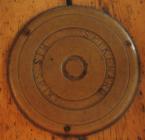 Credits:
Credits:Crow's Nest Officers Club
10
Lieutenant. Commander. H. G. Shadforth and Two OthersCirca 1942
St. John's, Newfoundland, Canada
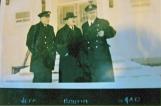 Credits:
Credits:2007-2008 Album, Crow's Nest
